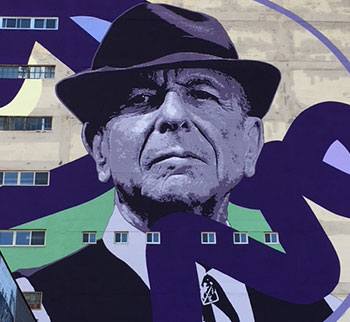On the sidewalk in front of 28 Rue Vallières in the old Jewish quarter of Montreal, known as the Plateau, a stencil of the word “Hallelujah” was being spray painted in large, yellow letters and anchored to the cement by a solid grey stone. A group, including myself, watched as devoted fans paid homage to Leonard Cohen with his own words, in front of his home, on Nov. 7, the first anniversary of his death.
Montreal was alive with those still mourning the loss of a man who may have been the city’s most beloved citizen. The day before, while walking along the cobblestone streets of Old Montreal, I spoke with several people, some of whom I knew and many who I didn’t. Each one of us had a Leonard Cohen story that we couldn’t wait to share, often with tears in our eyes. People had come from around the world to honour Cohen’s memory and join in the “tower of song” that evening at t
he Bell Centre. An international roster of performers, orchestrated by his son, Adam Cohen, included Sting, Elvis Costello, k.d. lang, Sharon Robinson and Damien Rice, performed Cohen’s songs before a cheering crowd of upwards of 20,000. But it was a video of Cohen reciting A Thousand Kisses Deep that brought the weeping audience to its feet. It was a love fest, the likes of which I have seldom encountered.
The next day, I was among a group of journalists taking a walking tour
of Cohen’s neighbourhood. It w
as mostly a nostalgic nosh of Montreal’s Jewish eateries and a guide to historic Jewish landmarks. Each and every place we visited had a photo or newspaper clipping of Cohen wearing his signature grey fedora.
Our eating marathon began at Lester’s Deli, which dates back to 1951. Below the counter, covered with plates of smoked meat piled between pieces of light rye, with a squeeze of mustard and a side of pickles, was a photo of Cohen with his intense eyes and shy smile. From there, it was off to the St. Viateur Bagel Shop, an institution since 1957, where some 12,000 bagels are hand rolled, coddled in boiling water and paddled out of a wood-burning fire each day. On one wall laden with celebrity photos was Cohen arm-in-arm with St. Viateur’s owner, Joe Morena.
READ: LEONARD COHEN’S SON SAYS MONTREAL CONCERT ACCORDS WITH FATHER’S WISHES
Later, after we’d munched on bagels from Fairmount Bagel, there ensued an almost Talmudic debate on which was the best bagel and why. On it went until we arrived at Wilensky’s, where egg cream sodas and fried meat sandwiches supplanted the bagel argument. Cohen peered down from his photo on high, no doubt with amusement at our out-of-control fressing.
As we meandered along, our guide pointed out and recounted stories about the old Bagg Street Shul, where Mordecai Richler grew up. We studied the eclectic designs of the old wooden staircases and the innumerable graffiti designs and murals, but none was quite as impressive as the gigantic, nine-story mural of Cohen on the outside of the Cooper building, off St-Laurent, that was created by Kevin Ledo. I’m your man came to mind: an honest, direct gaze, filled with gravitas and wisdom – both knowing and sensual. Another mural of Cohen stands sentinel on Crescent Street in downtown Montreal, but it seems strangely out of place.
Over at the Museum of Jewish Montreal on Boul. St-Laurent, Cohen’s most familiar lyrics were scattered on a table inviting visitors to create their own poems using the words.
The Musée D’Art Contemporain de Montreal’s (MAC) exhibition, Leonard Cohen: A Crack in Everything, opened the next day. The museum’s director and chief curator, John Zeppetelli, said that, “Leonard Cohen’s thinking, writing and music are a thing of beauty and despair … depicting both an exalted spirituality and an earthly sexuality.” In an attempt to communicate their version of his genius, 40 local and international artists from 10 countries created 20 multidisciplinary works.
Depression Chamber by Ari Folman, an Israeli director and screenwriter, leads the viewer into a sarcophagus-like environment one person at a time, where people lie down on a bed and look up. That’s all I can describe without giving anything away. Let’s just say the rest is pure beauty and imagination. Meanwhile, in When Even The, a solo dance performance inspired by Cohen’s poem, Clara Furey, wearing only jeans, her supple body shifting into impossible shapes, is an existential reflection on memory, the passage of time and death.
The exhibition also includes I Heard There Was a Secret Chord, a participatory humming experience by the creators Daily tous les Jours that joins people around the world while listening to Hallelujah. Visitors hum into microphones dangling in a circle, while physical vibrations induce a deep emotional response. Passing Through by video artist George Fok is an immersive, 360-degree video work that pays tribute to Cohen’s five decades as a singer, songwriter, poet and performer. The room is dark, the sofas cozy, the memories unforgettable. It was the perfect dénouement to three days of celebrating the life and art of Leonard Cohen. After spending five hours at the museum, I reluctantly took my leave. It was closing time.

